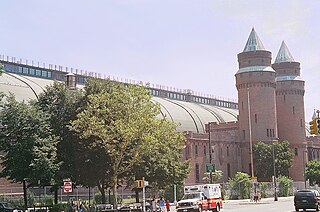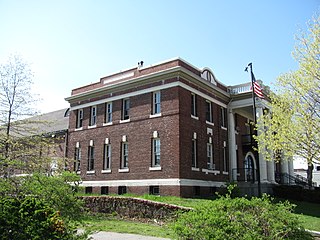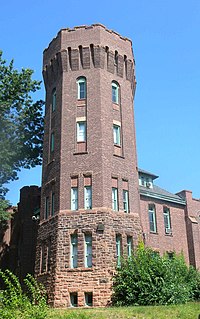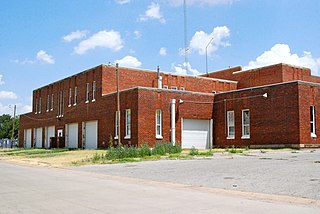
The Kingsbridge Armory, also known as the Eighth Regiment Armory, is a decommissioned armory at Jerome Avenue and West Kingsbridge Road in the Kingsbridge neighborhood of the Bronx in New York City. It was built in the 1910s, from a design by the firm of then-state architect Lewis Pilcher to house the New York National Guard's Eighth Coast Defense Command, a regiment-sized unit which relocated from Manhattan in 1917. It is possibly the largest armory in the world.

The Armory, historically known as the First Regiment Armory Annex, and now called Portland Center Stage at The Armory, is a historic building with two theaters inside and is located in Portland, Oregon, United States and is home to the theater company, Portland Center Stage. It was built in 1891 by Multnomah County to house the Oregon National Guard. In 2000, it was added to the National Register of Historic Places. Following a $36.1 million renovation project that lasted from 2002 to 2006, the building home to the theater company Portland Center Stage which produces 11 productions each season. An estimated 150,000 visitors visit The Armory annually to enjoy a mix of classical, contemporary and world premiere productions, along with the annual JAW: A Playwrights Festival, and a variety of high-quality education and community programs.

The Massachusetts State Armory is a historic armory in Wakefield, Massachusetts. Built in 1913, it is a fine local example of Classical Revival architecture, and a symbol of the town's long military history. The building was listed on the National Register of Historic Places in 1989. It presently houses the Americal Civic Center, a local community center.

The Denton Armory is a historic armory located at Denton, Caroline County, Maryland.

The Flushing Armory is a historic National Guard armory building located in Flushing, Queens. New York City. It is a brick and stone castle-like structure built in 1905–1906, designed to be reminiscent of medieval military structures in Europe. It was designed by state architect George L. Heins.

The Schenectady Armory is located on Washington Avenue in the city of the same name in the U.S. state of New York. It is a brown brick building dating to 1936.

The Enid Armory was located in Enid, Oklahoma and has been listed on the National Register of Historic Places since 1988. The two-story building was constructed in 1936 as a Works Progress Administration project. It was the third largest Armory in Oklahoma.

Gloversville Armory is a historic National Guard armory building located at 87 Washington Street in Gloversville, Fulton County, New York. It is a brick and red sandstone castle-like structure built from 1903 to 1904, designed to be reminiscent of medieval military structures in Europe. It was designed by State Architect George L. Heins in the Late Victorian style.

The Historic First Presbyterian Church in Elizabethtown, Kentucky, was a historic church at 212 W. Dixie Avenue. It was added to the National Register of Historic Places in 1988.

The New Scotland Avenue Armory is located on New Scotland Avenue in Albany, New York, United States. It is a large brick building constructed in the early 20th century. In 1994 it was listed on the National Register of Historic Places, one of two armories in the city of Albany to be so designated.

The Gettysburg Armory is a former National Guard armory located at Gettysburg, Adams County, Pennsylvania. It was listed on the National Register of Historic Places in 1990. The 61x96 ft Art Deco facility was constructed as a $43,331 Works Projects Administration project for the local National Guard unit. The two-story building housed a garage and repair shop for military vehicles, a classroom, administrative space, and a drill hall. From the beginning, the Armory was used not only by the National Guard, but also by the local community, for sporting events and community meetings. In 1944, the Gettysburg Armory was used as a temporary German Prisoner of War camp while the official camp was being constructed on the Gettysburg Battlefield. Later the building was designated as a public fallout shelter by the National Fallout Shelter Survey.

Special Troops Armory, also known as Philadelphia Armory, is a historic National Guard armory located in the Ogontz neighborhood of Philadelphia, Pennsylvania, United States. It was built in 1938, and is an "I"-plan, brick building in the Moderne style. It consists of a two-story front section, two-story drill hall, and one-story rear section. The front section is seven bays wide, with the center five bays slightly projecting. During World War II it was used to house German prisoners of war.

Frankel & Curtis was an architectural firm of Lexington, Kentucky. It was a partnership of Leon K. Frankel and of John J. Curtis, along with associates James Slaughter Frankel and Melbourne Mills. A successor name is Frankel, Curtis & Coleman. Under this name, the firm received a 1963 American Institute of Architects Kentucky award, its Honor Award merit prize, for its Admin. Bldg., of the Spindletop Research Center, in Lexington, Kentucky.

The Deming Armory is a historic armory in the United States, located at 301 South Silver Avenue in Deming, Luna County, New Mexico. The building was built for the United States Department of the Army in 1915–16, and is currently being used as the premises for the local museum in Deming. The armory was added to the New Mexico State Register of Cultural Properties in 1978 and was listed on the National Register of Historic Places in 1983.

The Helena National Guard Armory is a historic armory building at 511 Miller Street in Helena, Arkansas. It is a single story brick and masonry structure, built in 1936-37 using Works Progress Administration funds to house the Battery G of the 206th Coastal Artillery. The building's main facade as strong Art Deco styling, with its predominantly brick facing topped by concrete courses, and a strong vertical emphasis achieved by two towers and four pilasters on a pointed-arch roofline. The building housed a variety of military companies between its opening and its closure in 1978.
Helm Place is a white-columned, brick mansion built by John LaRue Helm in the 1830s, about one and a half miles north of the center of Elizabethtown, Kentucky. It was added to the National Register of Historic Places in 1976.
The Philip Arnold House, at 422 E. Poplar St. in Elizabethtown, Kentucky, is an Italianate-style house built in 1869. It was listed on the National Register of Historic Places in 1988. The house was home of Philip Arnold, a confidence man at the center of the Diamond hoax of 1872.

The Ravenna Motor Vehicle Service Building, at 512 Main St. in Ravenna, Kentucky, is a Modern Movement-style Kentucky National Guard building constructed in 1949. It was listed on the United States National Register of Historic Places in 2000.

The Marshall Street Armory is a former armory for the Michigan National Guard. It was listed on the National Register of Historic Places in 2010.

















